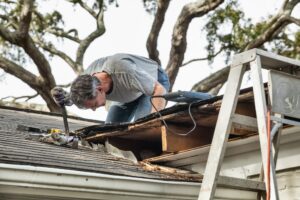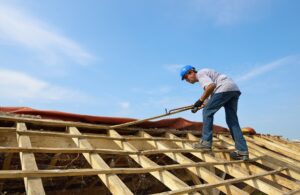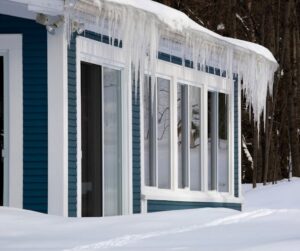High winds, weather from a tornado, or just a regular storm can be especially hard on the roof. If you spot the damage early, you may be able to avoid a roof replacement because a repair will suffice. Know the common types of roof wind damage so you can spot problems quickly if they occur.
Shingle Damage
Shingle damage is the most obvious type of problem after a windstorm. The wind can easily blow shingles off the roof, or they may be knocked loose or become torn.
Often, you can spot this damage simply by walking around your yard or looking at your roof. Look for bits of broken shingles laying about, and inspect the roof for missing, torn, or askew shingles. Take care if you are missing a lot of shingles, since there may also be roofing nails laying in the yard.
Repair Options
Your repair options depend upon the severity of the damage. If only a few shingles are broken or missing, you can usually just have these replaced. On the other hand, if the roof has extensive shingle damage, a new roof may be the better option.
If you decide to get a new roof, opt for wind resistant T-lock shingles instead of the standard three tab shingles.
Granule Loss
Asphalt shingles feature a coating of gravel granules. These granules protect the shingle while also further ensuring the roof’s waterproof capabilities. If you lose too much of this coating, your shingles will degrade more quickly, and they are also more likely to develop leaks. Wind, heavy rain, and hail can all lead to granule loss.
You can spot granule loss in a couple ways. The most obvious is to look in your gutters or along the dripline under the eaves for heavy gravel buildup. You can also survey the shingles for smooth, shiny spots that indicate fewer granules.
Repair Options
Unfortunately, you can’t simply recoat the shingles with fresh granules. In most cases the entire roof will require replacement unless the damage is localized. For example, if the granule loss is only in a small area, perhaps due to a falling tree branch, you may be able to only have that section of shingles replaced.
Just keep in mind that it can be difficult to color match the replacement shingles if the roof is more than a couple of years old.
Vent and Flashing Damage
Vents, chimney pipes, and flashing are just a few of the non-shingle items on your roof that are prone to wind damage. If a piece of flashing is damaged, water can leak beneath it. The same goes for a damaged vent pipe; if the wind dislodged it, then a leak may have opened up at its base.
Twisted and warped flashing can be easy to spot from the ground, as is some damage to vents and chimney caps. If you suspect an issue that you can’t see, a roofing contractor can do a more thorough inspection.
Repair Options
Fortunately, most vent and flashing issues are simple repairs. A roofer can quickly replace the damaged piece with a fresh piece of flashing. As for vents, a repair of the boot and recaulking around the base is all that’s needed.
Eave and Gutter Damage
Wind can be particularly hard on the eaves and gutters, thank to uplift at the edge of the roof. For example, high wind can pull or twist the gutters right off your roof.
Gutter damage can lead to damage of the eaves, since dislodged gutter fasteners can rip holes in fascia boards. If the winds are severe enough, they may even drive water into the soffit vents, which can lead to wood rot damage to the eaves.
Repair Options
Damage to the gutters and eaves tends to be localized, so you’ll likely only need to repair a small area. Simply replace the damaged length of guttering or fascia and soffit. If you spot the damage long after the storm, you may need to check for rot. Stick a screwdriver into the fascia board and if it sinks in more than 1/8 inch, you likely have rot.
Contact Precise Roofing and Contracting, LLC Roofing & Contracting for more assistance with your wind damaged roof.





